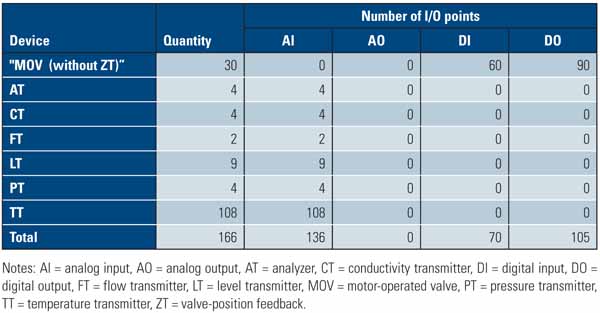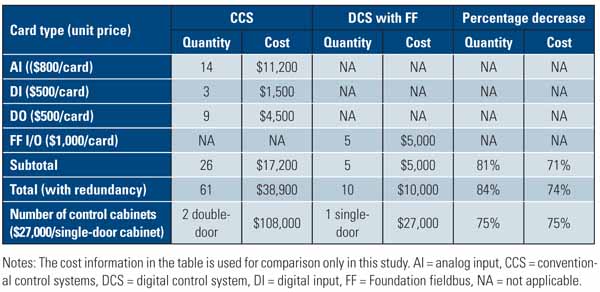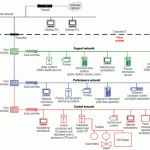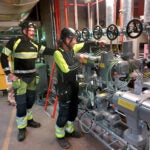Digital fieldbus technologies, including Foundation fieldbus and Profibus, are increasingly being used with success in the nuclear and fossil fuel power industries. This article compares a conventional control system with a Foundation fieldbus – based digital control system used in a typical circulating water system in a nuclear power plant. As shown in this example, using digital fieldbus technologies can result in significant savings in terms of installation and hardware costs.
Advanced digital fieldbus technology is an all-digital, multidrop, bidirectional serial communication bus that connects microprocessor-based control and field devices. In addition, this technology serves as a local area network for the instrumentation and control systems used within power plants and other industrial facilities that have the built-in capability to monitor and distribute control applications across a network. This technology therefore offers an open architecture for control and information integration. Advanced digital fieldbus technology has already gained wide acceptance in a number of industries, including the oil and gas, petrochemical, and pulp and paper industries. Its popularity is growing in the fossil fuel power industry, but it is being adopted much more slowly in the nuclear power sector.
The benefits achieved with this technology include lower installation costs, easier troubleshooting, improved maintenance, and extensive diagnostics. Some advanced digital fieldbus technology applications have been implemented for nonsafety-related systems to retrofit the analog-based control systems in existing nuclear power plants. For example, Oconee Nuclear Station, located in Seneca, S.C., installed a Foundation fieldbus (FF) network and related field devices to replace obsolete pneumatic and electrical control and monitoring loops for its balance-of-plant systems. The application of advanced digital fieldbus technology has also been proposed for nonsafety-related systems in new reactor systems currently under U.S. Nuclear Regulatory Commission (NRC) review. The technology has also been proposed for use in safety-related systems in the U.S. nuclear power industry. Moreover, digital fieldbus technology has been tested internationally for use in nuclear plant safety applications.
For years, the industry has investigated ways to use digital fieldbus communications with field devices without the need for a separate cable for each. Many types of digital fieldbus technologies exist; however, two digital fieldbus platforms have emerged as leaders for process control systems: Foundation fieldbus and Profibus (process fieldbus). See the sidebar for a discussion of the differences between them.
Digital Fieldbus Technologies and Their Benefits
Digital fieldbus technology can be defined as a communication protocol that allows two-way digital communications among various control devices such as those used in control room equipment. Many types of fieldbus architectures are available for use, including FF, Profibus, ControlNet, DeviceNet, AS-i, World-FIP, and Interbus. Among the available fieldbus technologies, FF and Profibus have been widely acknowledged, accepted, and used because of their simplicity, flexibility, and international and interoperable standards.
Compared with conventional control systems (CCSs) that use point-to-point hardwired technology, a fully digital control system (DCS) using FF or Profibus offers the following lifecycle benefits.
Reduced Costs. The following five factors illustrate why digital fieldbus technology reduces costs significantly — although the required terminators, connectors, and power conditioners may offset the savings to some extent:
-
Because digital fieldbus technology allows multiple devices to use a single wire pair, less wire and conduit, fewer cable trays, and smaller control cabinets are needed.
-
Standard function blocks, which are used in digital fieldbus technology to implement control strategies, reduce the amount of system hardware needed, including input/output (I/O) converters, power supplies, and cabinets.
-
Multivariable digital fieldbus transmitters with close-coupled mounting eliminate the need for temperature transmitters.
-
Power loads on control room equipment and the size of control cabinets are reduced because of the reduction in the number of I/O cards that are required.
-
Reduced hardware simplifies start-up and parameterization operations and reduces installation time, commissioning time, and construction costs.
Improved System Operation. Digital fieldbus technology allows multiple variables from each device to be brought into the control system for remote diagnostics, archival activities, trend analysis, process optimization studies, report generation, predictive maintenance, remote configuration, and asset management.
Decreased Risks of System Failure and Increased Operating Reliability. The self-test and communication capabilities of microprocessor-based digital fieldbus devices help reduce downtime and improve plant safety. Plant operations and maintenance personnel can be notified upon detection of abnormal conditions or the need for preventive maintenance, allowing them to initiate corrective action quickly and safely.
Enhanced Plant Performance and Asset Management. Digital fieldbus technology enables asset management functions such as diagnostics, calibration, identification, and other maintenance management operations to "mine" massive amounts of information from field devices in real time.
Increased Flexibility and Interoperability. Because digital fieldbus technology has an open protocol, different subsystems from different suppliers in a nuclear power plant can be easily integrated, and information can be accessed without the need for custom programming.
A Digital Control System Trumps a Conventional Control System
The following example describes a typical circulating water system in a nuclear power plant that uses cooling towers in order to demonstrate the installation and hardware cost benefits derived from using digital fieldbus technology. For the purpose of simplicity, this example uses only the FF. However, as described earlier, a mixed system that incorporates both leading digital fieldbus technologies may be a better solution for some applications.
Table 1 lists 166 candidate field devices and 311 related I/O points for this typical circulating water system. The discrete I/O points associated with the pump and fan controls used in the circulating water system are not included because they are more appropriately controlled by using Profibus technology. In addition, this example does not include monitoring of the vibrations caused by the pumps and fans because these devices are usually wired to a packaged vibration-monitoring system. If this example also included discrete control and vibration monitoring using a diverse fieldbus-based system, more benefits could be achieved.
1. Field devices and related I/O points of the circulating water system. Source: Jack Y. Zhao

The following assumptions were made for this comparison:
-
Transmitters and valves are connected to I/O cards through junction boxes.
-
A maximum of 16 wires, each of which has three terminations (a twisted pair with shielding), can be connected to each junction box.
-
A maximum of eight devices can be attached to one H1 segment.
-
Each analog input (AI) card can accommodate 10 channels, and each digital input (DI) card can accommodate 24 channels in a CCS. Each field-powered digital output (DO) card selected to provide DO signals can accommodate 12 channels.
-
Each FF I/O card can accommodate 64 channels.
-
Each double-wide control cabinet, 1,600 by 800 millimeters (mm) in size, can accommodate about 30 conventional I/O cards and the related power supplies, communication devices, and other necessary equipment.
Reduction in Input/Output Terminations
With a CCS, 311 I/O points require three sets of 933 ((311 x 3) x 3 = 2,799) terminations:
-
311 wires from 311 I/O points to 933 terminations into junction boxes
-
933 terminations from junction boxes into I/O cards
In a DCS using FF technology, 166 devices can be divided into at least 21 H1 segments, requiring 540 (498 + 21 x 2 = 540) terminations, as follows:
-
166 wires from 166 candidate devices to 498 terminations (166 x 3 = 498) into junction boxes
-
21 terminations from 21 H1 segments into I/O cards
According to the analysis above, FF technology can lead to an 81% reduction in the number of terminations. This reduction decreases installation costs (assuming $15 per termination installation):
-
CCS with 2,799 terminations: $41,985
-
FF-based DCS with 540 terminations: $8,100
-
Savings with FF: $33,885
Reduction in Number of I/O Cards and Control Cabinets
The candidate field devices using FF technology in a typical circulating water system, which uses cooling towers, require 136 AIs, 70 DIs, and 105 DOs (see Table 1). A total of 61 I/O cards are needed for a CCS to operate under conditions of double redundancy for DI cards and triple redundancy for DO cards. However, if FF technology is used, only 10 I/O cards are needed to achieve double redundancy. FF technology thus decreases the number of I/O cards required by 84% and decreases hardware costs by 74%, as shown in Table 2.
2. Savings in I/O cards and control cabinets. Source: Jack Y. Zhao

In addition to simplified cabling and reduced power requirements, the reduction in I/O cards leads to a significant reduction in the size of the control cabinet. Sixty-one I/O cards with remote-multiplexing unit communications and the associated power supplies for a CCS would require about two double-door 1,600 by 800 mm cabinets, which cost about $108,000. In contrast, 10 FF I/O cards with their related communication cards and power supplies can be contained in one single-door 800 by 800 mm cabinet, which costs about $27,000. In addition to the reduction in required building space; civil design; and heating, ventilation, and air conditioning, the use of FF technology can reduce the cost of control cabinets by 75%.
Reduction in Home-Run Wiring
With a CCS, a total of 311 home-run wires are needed to connect junction boxes to I/O terminations. If FF technology is used, only 21 wires are required to connect H1 segments to I/O terminations, leading to a 93% reduction.
Potential Licensing Implications and Issues for Safety-Related Nuclear Systems
The application of digital fieldbus technology has a successful track record in fossil fuel power and nonsafety-related nuclear systems. However, digital fieldbus technology has not yet been applied to safety-related systems in the nuclear power industry. There are a number of reasons why the industry has been slow to adopt this technology despite its promising features and benefits. First, because of the safety-critical nature of the nuclear power generation process, the industry has historically been slow to adopt new technologies that have a perceived risk to safety, availability, and reliability. Second, the digital fieldbus – based approach can directly affect many aspects of a nuclear power plant, including the regulatory and licensing process, design specifications and equipment procurement, construction, start-up, and operation. Other issues that limit the quick adoption of digital fieldbus technology include a lack of workforce knowledge, regulatory uncertainty, and lack of management and employee acceptance. In addition, this technology is unproven in safety-critical applications.
Considering that other industries have successfully implemented digital fieldbus technology in their operations, the nuclear power industry should not preclude the application of this technology from its safety-related nuclear systems. However, specific regulations or guidelines do not currently exist to address the application of digital fieldbus technology to safety-related nuclear systems. That is why it is important to examine the potential licensing implications and deployment issues for applying this technology to safety-related nuclear systems from a regulatory point of view. The rest of this section addresses some of those issues.
First-of-a-Kind Engineering. Both FF safety-instrumented-functions technology and Profibus PROFIsafe communication protocols have been approved up to International Electrotechnical Commission (IEC) 61508 Safety Integrity Level 3 for their use in safety-related applications. However, these two platforms have not yet been approved and used for safety-related nuclear systems. All the issues related to first-of-a-kind engineering need to be addressed before the technologies can be used in safety-related nuclear systems.
Cyber and Physical Security. Because FF technology control functions are executed in field devices, physical security must be addressed to prevent tampering with those fieldbus field devices. More importantly, an FF-based DCS may have more severe vulnerability issues involving cyber security than a CCS because of the communication features of fieldbus technology, including remote configuration and diagnostics, field execution of control functions, and multiple device connections in the same control loop.
Diversity and Defense-in-Depth Issues and Common-Cause Failure. Although the FF-based DCS can be designed to be redundant, common-cause failure from both hardware and software design features will need to be addressed to meet the separation and independence requirements. If different fieldbus technologies are used to address diversity and defense-in-depth issues, the interoperability of the device within the integrated control system needs to be carefully reviewed.
Safety Analyses. The nuclear power industry needs to analyze selected fast processes to ensure that the communication speed of digital fieldbus devices — especially FF and Profibus-PA — is fast enough to meet plant conformance to safety analyses, such as accident and transient analyses.
Environmental Qualifications. Ideally, fieldbus technology would be effective in Class 1E mild and harsh environments from a maintenance and diagnostics perspective. However, for Class 1E harsh environments inside the containment structure where there are high levels of radiation, the microprocessor-based fieldbus devices usually do not fare well. In addition, if fieldbus devices are to be used in Class 1E environments, they must be qualified to environmental standards such as IEEE Standards 323 and 344, which include testing for seismic effects, thermal aging, radiation aging and hardening, vibration, and loss-of-coolant accidents.
Looking Ahead
Because there is no existing standard or guidance specifically created to address the application of digital fieldbus technology to safety-related nuclear systems, digital fieldbus – based safety control systems shall be developed and validated in the same manner as other existing digital safety control systems according to current regulations and guidelines, However, in the future, specific guidelines or standards will need to be established to address the application of digital fieldbus technology to safety-related nuclear systems.
The information and conclusions presented herein are those of the author and do not necessarily represent the views or positions of the U.S. Nuclear Regulatory Commission. Neither the U.S. Government nor any agency thereof, nor any employee, makes any warranty, expressed or implied, or assumes any legal liability or responsibility for any third party’s use of this information.
—Jack Y. Zhao (jack.zhao@nrc.gov) is senior electronics engineer (digital I&C) for the U.S. Nuclear Regulatory Commission in the Instrumentation, Controls, and Electrical Engineering Branch No. 2 Division in Rockville, Md.










